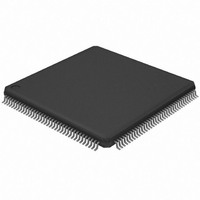AT94K05AL-25BQU Atmel, AT94K05AL-25BQU Datasheet - Page 74

AT94K05AL-25BQU
Manufacturer Part Number
AT94K05AL-25BQU
Description
IC FPSLIC 5K GATE 25MHZ 144-LQFP
Manufacturer
Atmel
Series
FPSLIC®r
Datasheet
1.AT94K05AL-25AJI.pdf
(204 pages)
Specifications of AT94K05AL-25BQU
Core Type
8-bit AVR
Speed
25MHz
Interface
I²C, UART
Program Sram Bytes
4K-16K
Fpga Sram
2kb
Data Sram Bytes
4K ~ 16K
Fpga Core Cells
256
Fpga Gates
5K
Fpga Registers
436
Voltage - Supply
3 V ~ 3.6 V
Mounting Type
Surface Mount
Operating Temperature
-40°C ~ 85°C
Package / Case
144-LQFP
For Use With
ATSTK594 - BOARD FPSLIC DAUGHTER FOR STK500
Lead Free Status / RoHS Status
Lead free / RoHS Compliant
Eeprom Size
-
Available stocks
Company
Part Number
Manufacturer
Quantity
Price
- Current page: 74 of 204
- Download datasheet (4Mb)
4.18.3.1
4.18.4
4.18.5
74
AT94KAL Series FPSLIC
Using the Boundary-scan Chain
Using the On-chip Debug System
TAP Controller
The TAP controller is a 16-state finite state machine that controls the operation of the Boundary-
Scan circuitry and On-Chip Debug system. The state transitions depicted in
on the signal present on TMS (shown adjacent to each state transition) at the time of the rising
edge at TCK. The initial state after a Power-On Reset is Test-Logic-Reset.
As a definition in this document, the LSB is shifted in and out first for all shift registers.
Assuming Run-Test/Idle is the present state, a typical scenario for using the JTAG interface is
As shown in
selecting JTAG instruction and using Data Registers, and some JTAG instructions may select
certain functions to be performed in the Run-Test/Idle, making it unsuitable as an Idle state.
Note:
A complete description of the Boundary-Scan capabilities are given in the section
(JTAG) Boundary-scan” on page
As shown in
All read or modify/write operations needed for implementing the Debugger are done by applying
AVR instructions via the internal AVR CPU Scan Chain. The CPU sends the result to an I/O
memory mapped location which is part of the communication interface between the CPU and the
JTAG system.
• At the TMS input, apply the sequence 1, 1, 0, 0 at the rising edges of TCK to enter the Shift
• Apply the TMS sequence 1, 1, 0 to re-enter the Run-Test/Idle state. The instruction is latched
• At the TMS input, apply the sequence 1, 0, 0 at the rising edges of TCK to enter the Shift
• Apply the TMS sequence 1, 1, 0 to re-enter the Run-Test/Idle state. If the selected Data
• A scan chain on the interface between the internal AVR CPU and the internal peripheral units
• A breakpoint unit
• A communication interface between the CPU and JTAG system
• A scan chain on the interface between the internal AVR CPU and the FPGA
• A scan chain on the interface between the internal Program/Data SRAM and the FPGA
Instruction Register - Shift-IR state. While TMS is Low, shift the 4 bit JTAG instructions into
the JTAG instruction register from the TDI input at the rising edge of TCK, while the captured
IR-state 0x01 is shifts out on the TDO pin. The JTAG Instruction selects a particular Data
Register as path between TDI and TDO and controls the circuitry surrounding the selected
Data Register.
onto the parallel output from the shift register path in the Update-IR state. The Exit-IR, Pause-
IR, and Exit2-IR states are only used for navigating the state machine.
Data Register - Shift-DR state. While TMS is Low, upload the selected Data Register
(selected by the present JTAG instruction in the JTAG Instruction Register) from the TDI input
at the rising edge of TCK. At the same time, the parallel inputs to the Data Register captured
in the Capture-DR state shifts out on the TDO pin.
Register has a latched parallel-output, the latching takes place in the Update-DR state. The
Exit-DR, Pause-DR, and Exit2-DR states are only used for navigating the state machine.
1. Independent of the initial state of the TAP Controller, the Test-Logic-Reset state can always be
entered by holding TMS High for 5 TCK clock periods.
Figure
Figure 4-17 on page
4-16, the hardware support for On-Chip Debugging consists mainly of
76.
73, the Run-Test/Idle
(1)
state need not be entered between
Figure 4-17
“IEEE 1149.1
1138I–FPSLI–1/08
depend
Related parts for AT94K05AL-25BQU
Image
Part Number
Description
Manufacturer
Datasheet
Request
R

Part Number:
Description:
IC FPSLIC 5K GATE 25MHZ 84PLCC
Manufacturer:
Atmel
Datasheet:

Part Number:
Description:
Fpslic Devices Combine 5K Gates of Atmel's Patented AT40K Fpga Architecture, a 20 Mips Avr 8-bit Risc Microprocessor Core, Numerous Fixed Microcontroller Peripheries And up to 36K Bytes of Program And Data SRAM.
Manufacturer:
ATMEL Corporation
Datasheet:

Part Number:
Description:
IC FPSLIC 5K GATE 25MHZ 84PLCC
Manufacturer:
Atmel
Datasheet:

Part Number:
Description:
IC FPSLIC 5K GATE 25MHZ 208PQFP
Manufacturer:
Atmel
Datasheet:

Part Number:
Description:
IC FPSLIC 5K GATE 25MHZ 144LQFP
Manufacturer:
Atmel
Datasheet:

Part Number:
Description:
IC FPSLIC 5K GATE 25MHZ 208PQFP
Manufacturer:
Atmel
Datasheet:

Part Number:
Description:
IC FPSLIC 5K GATE 25MHZ 144LQFP
Manufacturer:
Atmel
Datasheet:

Part Number:
Description:
IC FPSLIC 5K GATE 25MHZ 100-TQFP
Manufacturer:
Atmel
Datasheet:

Part Number:
Description:
Manufacturer:
Atmel
Datasheet:

Part Number:
Description:
Manufacturer:
Atmel
Datasheet:

Part Number:
Description:
Manufacturer:
Atmel
Datasheet:

Part Number:
Description:
5k - 40k Gates Of At40k Fpga With 8-bit Microcontroller, Up To 36k Bytes Of Sram And On-chip Jtag Ice
Manufacturer:
ATMEL Corporation
Datasheet:

Part Number:
Description:
At94k05al 5k - 40k Gates Of At40k Fpga With 8-bit Microcontroller, Up To 36k Bytes Of Sram And On-chip Jtag Ice
Manufacturer:
ATMEL Corporation
Datasheet:

Part Number:
Description:
DEV KIT FOR AVR/AVR32
Manufacturer:
Atmel
Datasheet:











